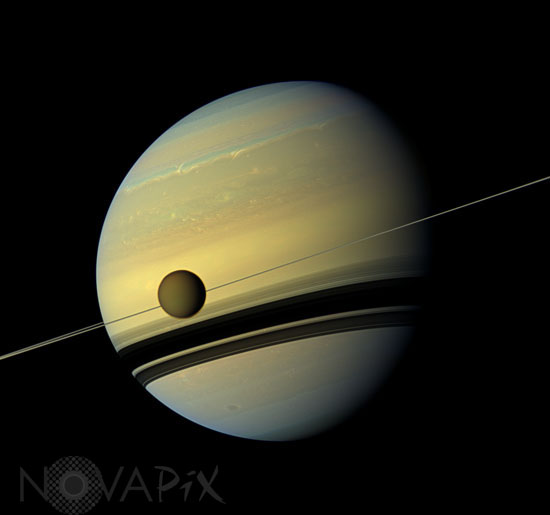Photo Agency - Astronomy - Space - Nature

Saturn and Titan seen by Cassini spacecraft
author: Nasa/JPL/SSI/Novapix
reference: a-sat05-10057
Image Size 300 DPI: 12 * 11 cm
A giant of a moon appears before a giant of a planet undergoing seasonal changes in this natural color view of Titan and Saturn from NASA's Cassini spacecraft. Titan, Saturn's largest moon, measures 3,200 miles, or 5,150 kilometers, across and is larger than the planet Mercury. Cassini scientists have been watching the moon's south pole since a vortex appeared in its atmosphere in 2012. As the seasons have changed in the Saturnian system, and spring has come to the north and autumn to the south, the azure blue in the northern Saturnian hemisphere that greeted Cassini upon its arrival in 2004 is now fading. The southern hemisphere, in its approach to winter, is taking on a bluish hue. This change is likely due to the reduced intensity of ultraviolet light and the haze it produces in the hemisphere approaching winter, and the increasing intensity of ultraviolet light and haze production in the hemisphere approaching summer. (The presence of the ring shadow in the winter hemisphere enhances this effect.) The reduction of haze and the consequent clearing of the atmosphere makes for a bluish hue: the increased opportunity for direct scattering of sunlight by the molecules in the air makes the sky blue, as on Earth. The presence of methane, which generally absorbs in the red part of the spectrum, in a now clearer atmosphere also enhances the blue. This view looks toward the northern, sunlit side of the rings from just above the ring plane.
This mosaic combines six images -- two each of red, green and blue spectral filters -- to create this natural color view. The images were obtained with the Cassini spacecraft wide-angle camera on May 6, 2012, at a distance of approximately 483,000 miles (778,000 kilometers) from Titan. Image scale is 29 miles (46 kilometers) per pixel on Titan.
Keywords for this photo:
2012 - ASTRONOMY - ATMOSPHERE - CASSINI - PLANET - RING - SATELLITE - SATURN - TITAN -
Contact : Stéphane Aubin +33-(0)9-51-26-53-76
© Novapix - All rights reserved


